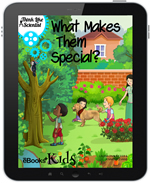How a Dog’s Paws Support K-5 In-the-Moment Assessment
By Carole Hayward
Posted on 2018-10-25
What special features of plants and animals can inspire solutions to human problems?
 That’s the driving question behind Jennifer Evans and Laura Chambless’s new eBook, “What Makes Them Special,” which provides K-5 students the engaging, highly interactive opportunity to be scientists and engineers while learning about structures and functions of animals and plants that live in their community.
That’s the driving question behind Jennifer Evans and Laura Chambless’s new eBook, “What Makes Them Special,” which provides K-5 students the engaging, highly interactive opportunity to be scientists and engineers while learning about structures and functions of animals and plants that live in their community.
This book, part of NSTA’s interactive eBooks+ Kids collection, takes students on a backyard exploration led by three characters, Lisa, DJ, and José, who help explain how nature has provided humans with many solutions to our problems. Students are given the opportunity to contemplate and ask lots of questions, define problems, analyze and interpret data, construct explanations, and argue from evidence. A companion Teacher’s Guide helps extend the learning experience into the classroom via shared discussions and activities.
When Chambless, the assistant director of K-5 math and science for the St. Clair County Regional Education Service Agency (RESA) in Marysville, Mich., learned that NSTA was seeking new authors–to write eBooks that helped teachers align their practice with the Next Generation Science Standards (NGSS) and Three Dimensional Learning–she turned to her good friend and colleague, Evans, who also works for the St. Clair County RESA as the assistant director of English Language Arts.
“Jennifer and I both work in the classroom with teachers and kids on a daily basis across seven different school districts in our area,” Chambless said. “This allows us to understand what teachers know, are able to do, what they are missing, and what they need help with.”
The book’s very first chapter, “What’s Special About Dogs Paws?” takes experiences familiar to students, such as seeing a dog’s paws and watching them run across a gravel driveway, and connects it to deeper learning about science and engineering. After exploring this chapter, students will be able to pose questions based on their observations; agree or disagree with arguments though listening to others’ ideas during discussions; develop a sound argument backed up with multiple points of evidence; and increase their knowledge and understanding by identifying key content vocabulary that becomes part of their usable language.
Given that higher levels of student engagement and accountability can be achieved via eBooks than with traditional textbooks, students transcend from being passive to active learners, Chambless said. “Our eBook presents eight science and engineering practices about kids doing science. Students learn how to critique the reasoning of their peers, using the evidence they learned in the book.”
“The questions that we have placed to teachers or students on each ‘page’ really make them think, at the right time, about what they just learned, what they just experienced. These eBooks allow students to explore at their own pace and then check to see if their thinking is on the right track. It’s an ‘in the moment’ assessment,” she added.
Both authors agreed that science educators need more teaching and learning resources that integrate content areas such as science and reading and writing so fluidly and easily.
“There is a natural connection with science and reading and writing,” Evans said. “More support is needed to expose teachers to the kind of resources that are available. In my experience, very few teachers are using enhanced eBooks. They just don’t know that they are available.”
Chambless and Evans expressed excitement as well as pride in being able to work together to produce resources that teachers can use in enhancing their instruction and better engage kids in the inquiry-based process of learning content.
“It was really cool to go into classroom where the students were doing an ELA writing lesson and I told them that I was in the middle of writing this book,” Chambless said. “The students wanted to look at my rough draft to ‘see’ what a real author does.”
Chambless recently moved closer to Evans, which allows them to take evening walks through their neighborhood and talk about things such as their next collaboration.
Those evening strolls have been productive. The two are already at work on their next interactive e-book!
Follow NSTA
Disclaimer: The views expressed in this blog post are those of the author(s) and do not necessarily reflect the official position of the National Science Teaching Association (NSTA).


